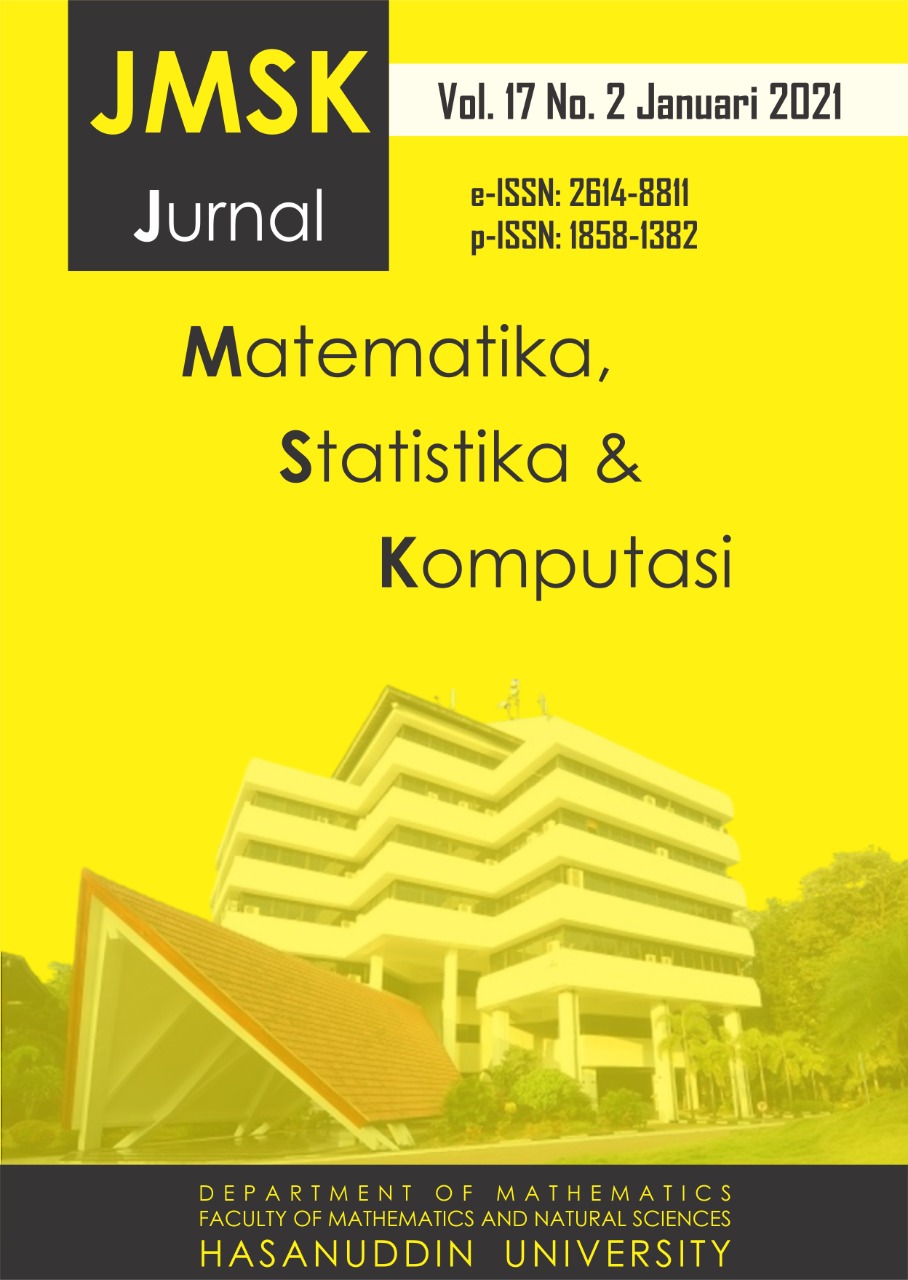Spatio-Temporal Model of Rainfall Data Using Kalman Filter and Expectation-Maximization Algorithm
DOI:
https://doi.org/10.20956/jmsk.v17i2.11918Keywords:
Spatial-Temporal Model, Kalman Filter, Expectation-Maximization Algorithm, Bootstrap, RainfallAbstract
Location and time dimension data modeling, also known as spatial-temporal data, generally has high complexity. This study analyzes a spatial-temporal model of rainfall data and climate variables, namely temperature, and humidity. The complexity of the relationship between variables and parameters in the spatial-temporal model is simplified by a hierarchical approach. The parameter estimation of the ratio-temporal model uses the Kalman Filter approaches and the Expectation-Maximization (EM) method combined with the bootstrap method to calculate the standard error estimation. Implementation of the spatial-temporal model on rainfall data in South Sulawesi Province with temperature and humidity shows that there is a relationship between rainfall and temperature and humidity.
References
Amran. (2011). Model Bayesian Hirarki Spatio-Temporal Nonstasioner Berbasis Kopula. Surabaya: Institut Teknologi Sepuluh November.
Bartolucci, F. F. (2012). Latent Markov models for Longitudinal Data. Baco Raton:Chapman & Hall/CRC.
Bilmes, J. A. (1998). A Gentle Tutorial of the EM Algorithm and its Application to Parameter Estimation for Gaussian Mixture and Hidden Markov Models. Retrieved November 2, 2016, from
http://www.melodi.ee.washingto.edu/people/bilmes/mypapers/em.pdf
Bilonick, R.A. (1983). Risk qualified maps of hidrogen ion contentration for the New York Stat area for 1966–1978. Atmospheric Environment, 2513–2524.
Cressie, N. A. (1993). Statistics for Spatial Data. New York: John Wiley & Sons.
Cressie, N., & Wikle, C. (2002). Space-time kalman filter. Encyclopedia of environmetrics, 2045-2049.
Durbin, J., & Koopman, S. (2001). Time series analysis by state space methods. New York: Oxford University Press.
Efron, B., & J. Tibshirani, R. (1993). An Introduction to the Bootstrap. Washington: Chapman & Hall/Crc.
Fasso, A., & Cameletti, M. (2017). A general spatio-temporal model for environmental data. Bergamo: GRASPA.
Hamilton, J. D. (1994). Time series analysis. New Jersey: Priceton University Press.
Henderson, H. V. (1978). On Deriving The Inverse Of A Sun Of Matrices. New York: Cornell University.
Hidayati, N. (2011). Estimasi Parameter Kelas Laten Menggunakan Algoritma Expectazion-Maximization. Surakarta.
Kharis, M. N. (2014). Analisis Peramalan Pendaftaran Siswa Baru Menggunakan Metode Seasonal ARIMA dan Metode Dekomposisi. Jakarta: Universitas Islam Negeri Syarif Hidayatullah.
LeSage, J. (1998). Spatial econometrics. United States: Department of Economics University of Toledo.
Little, R. J., & Rubin, D. B. (1987). Statistical Analysis with Missing Data. New York: John Wiley & Sons.
Mardia, K. a. (1993). Spatial-temporal analysis of mulitvariate environmental monitoring data. Multivariate Environmental Statistics, 347–386.
Maybeck, P. (1979). Stochastics Models, Estimation, and Control. New York: Academic Press.
Pfeiffer, d. (2008). Spatial Analysis in Epidemiologi. New York: Oxford University Press.
Rochmad. (2013). Aplikasi Metode Newton Raphson untuk Menghapiri Solusi Persamaan Non Linear. Jurnal MIPA, 193-200.
Rosadi, D. (2014). Analisis Runtun Waktu dan Aplikasinya dengan R. Yogyakarta: Gadjah Mada Univesity Press.
Samsiah, D. N. (2008). analisis data runtun waktu menggunakan model ARIMA (p,d,q). Yogyakarta: UIN Sunan Kalijaga.
Shumway, R. H., & Stoffer, D. S. (1982). An approach to time series smoothing and forecasting using the EM algorithm. Journal of Time Series Analysis, Wiley Blackwell, 253-264.
Taufik, I. (2017). Pemodelah Multilevel Survival Spasial dengan Pendekatan Bayesian. Makassar: Universitas Hasanuddin.
Vazquez, A., & Syversveen, A. (2006). the Ensemble Kalman Filter. Norwegia: Norsk Regnesentral.
Webster, R. &. (2007). Geostatistics for Environmental Scientists, 2nd Edition. United Kingdom: John Willey and Sons.
Weleh, G. &. (2006). An Introduction To the Kalman Filter. North Carolina: Department of Computer Science. University of North Carolina.
Welling, M. (2010). The Kalman Filter. California: California Institure of Technology.
Wuryandari, T. d. (2014). Identifikasi Autokorelasi Spasial pada Jumlah Pengangguran di Jawa Tengah menggunakan Indeks Moran. Media Statistika, 1-10.
Zucchini, W., & Mac Donald, I. (2009). Hidden Markov Models for Time Series-an Introduction Using R. London: Chapman & Hall.
Downloads
Published
How to Cite
Issue
Section
License
Copyright (c) 2020 Author and publisher

This work is licensed under a Creative Commons Attribution 4.0 International License.

This work is licensed under a Creative Commons Attribution 4.0 International License.
Jurnal Matematika, Statistika dan Komputasi is an Open Access journal, all articles are distributed under the terms of the Creative Commons Attribution License, allowing third parties to copy and redistribute the material in any medium or format, transform, and build upon the material, provided the original work is properly cited and states its license. This license allows authors and readers to use all articles, data sets, graphics and appendices in data mining applications, search engines, web sites, blogs and other platforms by providing appropriate reference.







